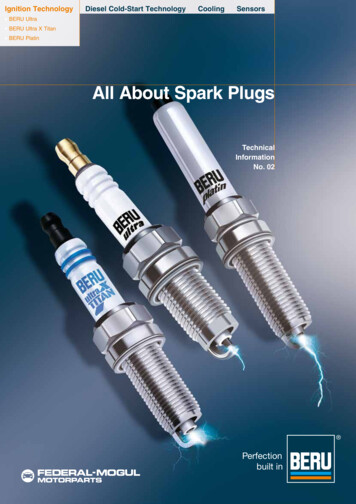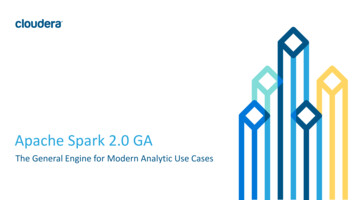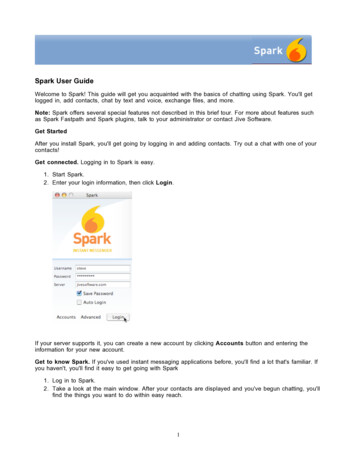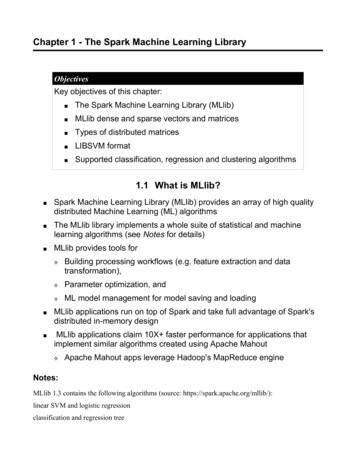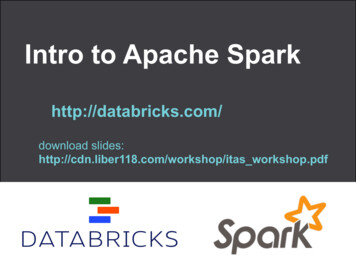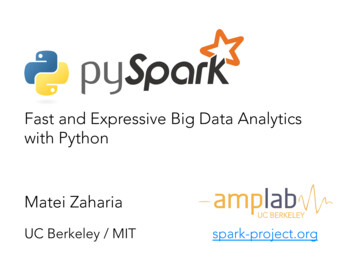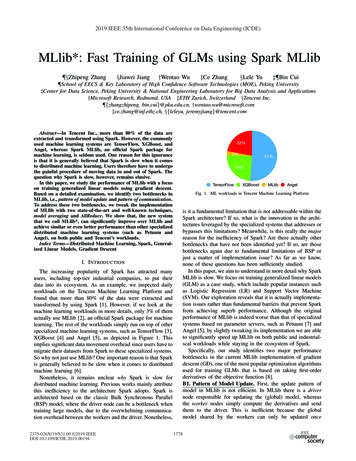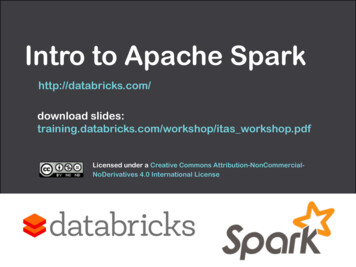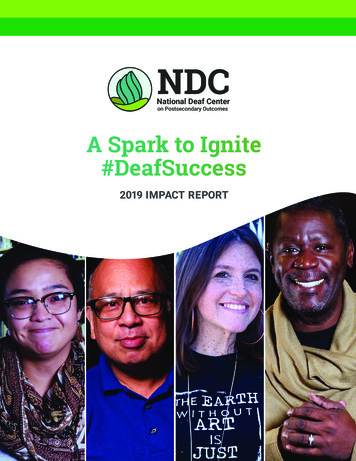
Transcription
NDCNational Deaf Centeron Postsecondary OutcomesA Spark to Ignite#DeafSuccess2019 IMPACT REPORT
Outcomes in Year 3:Impact, Intention, IngenuityDear Valued Colleagues,Welcome to our 2019 Impact Report, which tells the story of Year 3at the National Deaf Center on Postsecondary Outcomes (NDC).Our mission is as urgent as ever – to close substantial gapsin education and employment of deaf people – and to provideresults-driven accountability for our stakeholders, collaborators,and funding partners at the Office of Special Education andRehabilitative Services.Table of ContentsThree themes emerged at NDC in Year 3.Out-of-this-WorldConnection: Deafverse3Community Solutions:Engage for Change local4#DeafSuccess in Every State:Engage for Change state5Customized for Your Campus:Engage for Change on site6Access Through Education:Online Courses and Presentations7The Personal Touch:NDC help team8Modeling #DeafSuccess:Outreach9Project Opening Doors10Spotlight on 2019Resources11In this report, we highlight the very real systemic barriersthat deaf people face every day, then show how NDC activitiesaddress those barriers to effectively and efficiently achieve ourmandate. Read the success stories and learn how our diversestakeholders used NDC resources, tools, and evidence-basedresearch and insights to improve outcomes for deaf youthtransitioning to postsecondary life.IMPACTIn 2019, we built upon our infrastructure to addresscritical issues in very intentional ways. NDC expanded Engage forChange (EFC) models to focus on targeted content areas, createdsynergetic and seamless bundles of media-rich resources, andserved stakeholders from multiple entry points and across differentplatforms.INTENTIONINGENUITY When solutions seem hard to come by, we all need tosee innovative possibilities to our work. In 2019, ingenuity wasabundantly found in the passion and commitment of NDC staff,partners, task force members, and funders; in the tireless efforts ofstakeholders on the front lines; and in the often-unacknowledgedcontributions of deaf people in every community and state. These arethe sparks that ignite our success and light the way for NDC in Year 4.Yours in #DeafSuccess,Stephanie W. Cawthon, PhDDirector
Out-of-This-World Connection: DeafverseBARRIERDeaf youth need accessible and engagingtools to develop self-advocacy skills,which are essential for successfullynavigating schools, workplaces, andinaccessible environments.NDC APPROACHDeafverse, the first ASL-accessible online video game, engagesdeaf youth in an exciting choose-your-own-adventure world thatfosters self-advocacy and self-determination skills. Created bydeaf people for deaf people, the game is a deaf-centered resourcethat provides educators with an innovative teaching tool andcurriculum materials for the classroom.IMPACT“I think it’s an amazing experience because itapplies to me in a big way.”Deafverse makes a real, personal impact on theeveryday lives of the students who play the game,which can be seen in feedback from teachers andthe players themselves.“I have the right to say, ‘Hey, I want a replacement,a different interpreter,’” one student said. “I can dothat. I didn’t realize that I can do that.”Those little things can make a difference in asuccessful transition from high school to beyond.“You can experience different situations beforeyou actually experience them in real life,” oneplayer said. “Sometimes there are scary situationsout there.”And, since the information is presented in a fun,engaging way, the students actually pay attention.“Our students loved it,” one teacher said. “I haveseen them play it during lunch time.”Deafverse gives players a safe space to testout responses to those challenging situations.BY THE NUMBERS2019119,5172,501PLAYERS IN 201929,686HOUSEHOLDS REACHEDWHEN KXAN (NBC-TV)COVERED DEAFVERSE’SDEBUTVIEWS ON DAILY MOTH FEATURENational Deaf Center 2019 Impact Report3
Community Solutions:Engage for Change localBARRIERRobust local connections betweenfamilies, schools, businesses, andagencies are often missing or lacking,preventing sustainable opportunitiesfor deaf youth.NDC APPROACHEngage for Change local brings together youth, parents, andleaders to identify needs, share resources, and collaborate tocreate unique solutions for deaf youth in their community.These solutions reflect local values, amplify strengths, andprovide a critical missing link in systems change.IMPACT“More events like this are needed!”The need to move the needle on #DeafSuccessis a national problem. But solutions can startat home. That’s where EFC local starts — byidentifying community-specific opportunities andmaking a real impact with home-brewed solutions.In Columbus, Ohio, local leaders saw the benefitsof providing deaf youth with strong mentors,and are working collaboratively to create a newmentoring program for deaf people.“I have seen struggles with students and theirfamilies to obtain services and resources,” wroteone teacher of the deaf, describing the meeting as“a positive event to go forward to make excellentchanges in the community.”The initial meeting in New York City introducedleaders from various agencies, and a follow upmeeting got them really talking. They realizedthat each agency was collecting data that couldbe used by all the participants. They took actionto create a central database of information and adeaf education listserv.“This was a wonderful night and I truly learnedso much,” wrote one participant. “Having peoplefrom all aspects of the community come togetherto brainstorm is such a valuable/effective wayof addressing issues like this from a holistic andintersectional level.”BY THE NUMBERS2019181PEOPLE ATTENDED4 EVENTS IN NEW CITIES4National Deaf Center 2019 Impact Report119PEOPLE ATTENDED5 FOLLOW UP EVENTS
#DeafSuccess in Every State:Engage for Change stateNDC APPROACHBARRIERLeaders from state-level educationand vocational rehabilitationagencies often work in silos, withouteasy access to their peers andtailored resources.Engage for Change state provides essential data, planning tools,and networks of shared leadership and peer support that wouldotherwise be unavailable for state teams. State leaders acrossagencies collaborate to build sustainable programs that closeeducation and employment gaps for deaf youth.IMPACTEFC state makes an impact in countlessintangible ways — by connecting people, sharingideas, and supporting existing initiatives. Thoseconnections are the heart and soul of our initiativeto create #DeafSuccessInEveryState, because thetangible results are never far behind.EFC state holds a convening every year. In June,more than 80 leaders from 39 states gatheredto dive deep into NDC data and develop statepriorities and initiatives.The members of the West Virginia state teamwent home after the convening with an idea.After reviewing NDC’s research on the value of awell-implemented summer camp, they enrolledin the Developing Accessible Summer Programsonline course. Then, they enlisted the help of otherstate leaders to help them build a program thatwould work for their state.As a result, numerous young deaf people havemade new friends, connected with mentors andseen the limitless opportunities available forpeople like them as they transition from highschool to higher education, training or careers.They learned the skills they need to advocate forthemselves and drive their own futures.Rachel Torrence from the West Virginia stateteam said the state convening helped spurneeded change.“We are collaborating together and invitingmore people to the table, starting a discussionthat should have happened before,” she said.“I see a lot of change, and hopefully it will growinto the future.”BY THE NUMBERS201939STATES ATTENDED THE2019 CONVENINGSITE VISITSTO STATES52CHECK-INS WITH STATETEAMS DURING THE YEARNational Deaf Center 2019 Impact Report5
Customized for Your Campus:NDC on siteNDC APPROACHNDC on site is a hands-on, holistic strategy to addressaccessibility needs on campus. The team does a deep diveand supports disability professionals as they gain administrativebuy in, use tools to identify gaps in services, and createpolicies and practices that are responsive to the experiencesof deaf students.BARRIERColleges struggle with how to meetthe needs of deaf students, and deafstudents struggle with unmet needson campus.IMPACT“MATC’s mission includes providing open accessto quality higher education. We were looking tostrengthen this promise to ensure inclusion ofour deaf and hard of hearing students,” saidScott Ritter, Director of Disability Resources &Testing and Assessment Services. “Ourpartnership with NDC has provided the toolsand resources necessary to do just that.”Collaboration began when the NDC on siteteam went to the Wisconsin campus.“The team took the time to visit us in personand get to know our story, then provided a realisticand detailed action plan that was tailored toour college,” said Jana Mauldin, InterpreterCoordinator. “Ongoing questions have beenanswered thoroughly.”MATC took the action plan and ran with it,making changes in a number of different areas,including study abroad programs.Photo provided by Madison Area Technical CollegeMadison Area Technical College (MATC) wantedto improve access for deaf students, but campusleaders did not know where to start. They reachedout to NDC on site.But a major impact was the creation of a neworganization on campus, Deaf CommunityAssociation (DCA), to connect deaf studentsto each other. NDC research shows that deafstudents who are active in campus organizationsare also more likely to graduate.“I became really invested in [DCA], becausegrowing up I was mainstreamed. I always felt kindof outcast, so this felt like a great opportunity tomeet people like me,” student Chynna McNair toldMATC’s campus newspaper.BY THE NUMBERS20193CAMPUS VISITS FOR CUSTOMIZEDONSITE ANALYSIS6National Deaf Center 2019 Impact Report39ACTION STEPS RECOMMENDEDTO CAMPUSES
Access Through Education:Online Courses and PresentationsBARRIERThere is a shortage of onlineprofessional development to betterunderstand and serve deaf people ineducational and workplace settings.NDC APPROACHInnovative online course offerings meet the needs of professionalsat different stages in their careers and practice. These coursesintegrate personal stories from deaf people, research summaries,models from the field, and practical application activities to providean efficient and effective wrap-around approach.IMPACTFor deaf people to succeed, their environmentsneed to be accessible and welcoming. Peoplemake decisions every day that create thoseenvironments — sometimes with littleunderstanding about deaf people or their lives.NDC’s online courses and presentations aredesigned to improve understanding and expandknowledge, whether people are having their firstexperience with a deaf person or have workedwith deaf people for years.“Taking the Effective Communication classeshas given me so much to think about,” said anASL interpreter who works in elementary andsecondary schools.Another professional said the coursematerial was immediately applicable to newresponsibilities: “My current role is as a tempcoordinator of communication services at acollege. I was thrown into it and this coursecame at exactly the right time to help me withmuch-needed information.”Another way NDC expands access througheducation is by impactfully incorporating deafpeople’s personal stories into the online coursecontent. These stories connect data and researchto real people and their experiences.“[The course] helped me learn about situationsthat need accommodations that I had never eventhought about before,” a participant said. “One ofthe stories that really stuck out to me was the girlwho was in a class and the group met outside ofclass to work. I have had a lot of classes myself inwhich we met outside of class but never thoughtabout accommodations for that.”BY THE NUMBERS20192,975ONLINE COURSESCOMPLETED30PRESENTATIONS GIVENAT 18 CONFERENCES651PROFESSIONAL DEVELOPMENTCREDITS EARNEDNational Deaf Center 2019 Impact Report7
The Personal Touch:NDC help teamBARRIERMany people don’t know where to turnfor help navigating accommodationsor accessibility for deaf students,family members, or employees.NDC APPROACHAssemble a team of dedicated professionals from diversebackgrounds who answer questions from the field every day,including on an active listserv. They bring together availableresearch, evidence-based practices, case law, and real-worldinsights in timely, tailored responses, typically within two days.IMPACTNavigating accommodations and access can bedaunting. Deaf people and their families may notknow where to start or their rights under the law.Schools and employers struggle to balance theirown resources and best practices.That’s where the NDC help team shines. Itprovides individualized assistance, support, andresources to ensure access for deaf people atschool, work, or any setting – and creates realimpact, one response at a time.In 2019, a parent reached out to the NDC helpteam about her son’s clinical rotation – requiredfor his graduate degree in physical therapy, yet astruggle for him to access.“We should be able to use this information toeducate and guide the professional staff both atthe school and in the clinical settings,” the parentresponded. “Also, it has put my mind at ease toknow that they cannot just pull the rug from underhim without giving him the support he needs anddeserves. He has worked too hard to lose theability to achieve his goal now!”A disability services professional turned to theNDC help team when one student required anassistive listening device (ALD) for class andanother student requested ASL interpretingservices – two new requests at this college.“Your [team] helped me locate and purchase theappropriate ALD [and] locate and employ a signlanguage interpreter,” the professional wrote,grateful for the help to support deaf students oncampus.BY THE NUMBERS2019419PERSONALIZED RESPONSESTO PEOPLE’S QUESTIONS8National Deaf Center 2019 Impact Report1,370SUBSCRIBERS TO THE LISTSERVFOR PROFESSIONALS
Modeling #DeafSuccess:OutreachBARRIERExamples of how deaf youth canthrive in strong support systemsare frequently not emphasized intranslations of research-to-practice.NDC APPROACHCurate and disseminate information across multiplecommunications platforms to boost visibility of #DeafSuccess andgo beyond simply sharing resources and connecting stakeholders.Utilize best practices in accessibility standards for all deaf-disabledaudiences, with a deaf-centered commitment to empower andmotivate transition-age youth.IMPACT“I see that students learned to be who theywant to be, or to be someone who would pay itforward.”The work we do at NDC is about so much morethan statistics and reports. It’s about believing indeaf students, and showing them how they canthrive and achieve their dreams.Whether we are reaching out digitally — throughour listserv, newsletter or social media — orin-person at conferences, task force meetingsand more, we constantly strive to show, ratherthan tell, what #DeafSuccess means.As part of this overall strategy, our social mediaplatforms are the perfect way to directly andindirectly spread that message to countlessstudents across the country.For example, Scott Daily shared NDC’s#DeafAtWork video featuring his story aboutbecoming a deaf police officer on his personalaccount. Thanks to that post, he connected witha mother of three deaf children who wanted tomeet him and see first-hand how he built thecareer he wanted. She wasn’t the only person toreach out.“I teach deaf education for middle school kids,”responded Rachel Pipkin on Facebook. “One of mystudents told me he wanted to be a cop but thathe couldn’t because of being deaf. I am so excitedto show this to him tomorrow!”BY THE NUMBERS2019220,964WEBSITE VISITORS13,884FOLLOWERS ONSOCIAL MEDIA38,896NEWSLETTERSUBSCRIBERSNational Deaf Center 2019 Impact Report9
Project Opening DoorsProject Opening Doors is an initiative that, alongwith on site and other campus access activities,includes a survey for students, faculty, anddisability support professionals on campus that ismeant to better understand — and improve — thecollege experience for deaf students. A full reportof the results of the survey will be released inFebruary 2020, but initial results already showareas for improvement.BY THE NUMBERS2019Participantsin the ongoingCampusAccessibilitySurvey:Initial findings from the study show:44977%report videos their classmates share are likely to not have captions20064%report campus housing does not have adequate accessibility11656%reported being unable to connect with role models on campusSTUDENTSFACULTYDISABILITY SERVICEPROFESSIONALSfeatures such as flashing-light doorbells48%of students report that formal feedback about their service providers(e.g., interpreters) is not collectedDefining DeafWhat we mean when we say “deaf”The National Deaf Center is using the term deaf in an all-inclusivemanner, to include people who may identify as deaf, deafblind,deafdisabled, hard of hearing, late-deafened, and hearingimpaired. NDC recognizes that for many individuals, identity isfluid and can change over time or with setting. NDC has chosen touse one term, deaf, with the goal of recognizing experiences thatare shared by all members of our diverse communities while alsohonoring all of our differences.10National Deaf Center 2019 Impact Report
Spotlight on 2019 ResourcesNew publications, findings, andresources provided evidence-basedinsights and data to decision-makers,professionals, educators, and familiesthroughout the United States and itsterritories. They include: R edefining “Evidence-Based” S upporting Deaf Veterans S erving Deaf Students in HigherEducation: A Toolkit for DisabilityServices Professionals27,397NUMBER OF RESOURCESPEOPLE DOWNLOADEDFROM THE NDC WEBSITEIN 2019 P ostsecondary Achievement ofBlack Deaf People in the UnitedStates: 2019 D eaf People and Employment in theUnited States: 2019 U ndergraduate Enrollment of DeafStudents in the United StatesNational Deaf Center 2019 Impact Report11
NDCNational Deaf Centeron Postsecondary ter.orgThis publication was developed under a jointly-funded grant through the U.S. Department of Education’s Office of SpecialEducation Programs (OSEP) and the Rehabilitation Services Administration (RSA) #H326D160001. However, the contentsdo not necessarily represent the positions or policies of the federal government.
MATC took the action plan and ran with it, making changes in a number of different areas, including study abroad programs. But a major impact was the creation of a new organization on campus, Deaf Community Association (DCA), to connect deaf students to each other. NDC research shows that deaf students who are active in campus organizations

